10 Really FUN Outdoor Activities in Columbia SC!
September 26, 2022
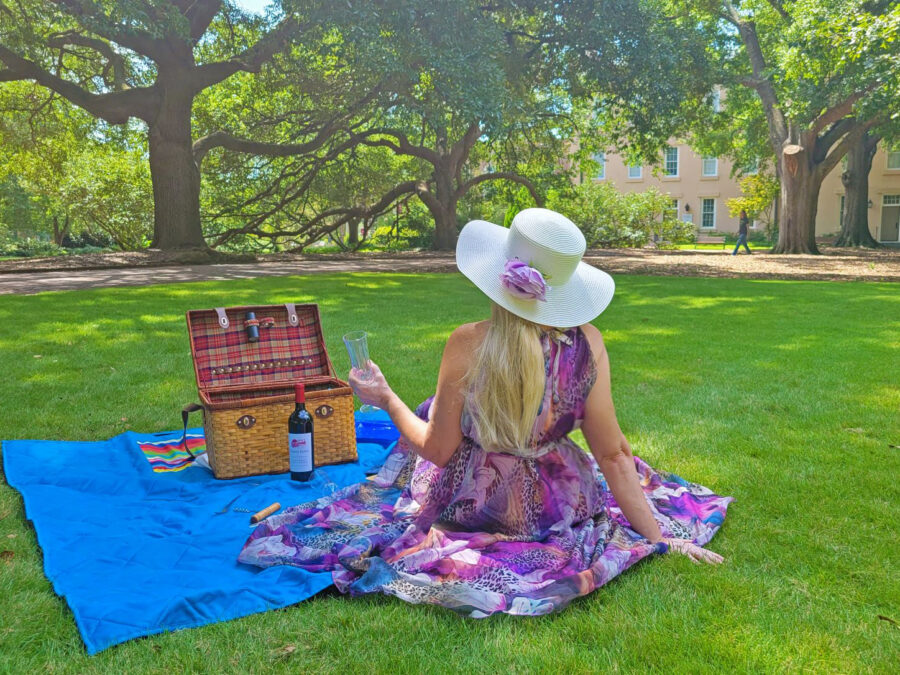
The capital and second-largest city in South Carolina, Columbia may not be the first place that comes to mind when you think about fun things to do. But it should. The vibrant city is known not only for its southern charm, important history, community of artists, collegiate excellence, and superb gastronomy but there are so many fantastic opportunities to get outside and enjoy a variety of outdoor activities in Columbia SC!
Just across the river from downtown, the Riverbanks Zoo and Botanical Garden is one of Columbia’s most attractive places to explore nature – even if you are not interested in seeing animals. Spanning 170 acres, 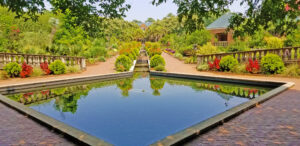 the highly acclaimed and award-winning park hosts an expansive garden taking up 70 acres and showcases 4,200 different kinds of plants both indigenous to South Carolina as well as exotic plants from all of North America. Be sure to take a walk on the 0.3-mile trail that starts at the Saluda Bridge and goes along the Saluda River which will bring you to the ruins of the old mill.
the highly acclaimed and award-winning park hosts an expansive garden taking up 70 acres and showcases 4,200 different kinds of plants both indigenous to South Carolina as well as exotic plants from all of North America. Be sure to take a walk on the 0.3-mile trail that starts at the Saluda Bridge and goes along the Saluda River which will bring you to the ruins of the old mill.
One of the most fun things to do is go on a scavenger hunt in the downtown area and see how many interesting and quirky pieces of art you can find in the alleys, plazas, and on buildings. The best is arguably “Tunnel Vision,” the 75 x 50-foot trompe l’oeil (trick the eye) mural created by South Carolina artist Blue Sky which gives the optical illusion of a portal to another world.
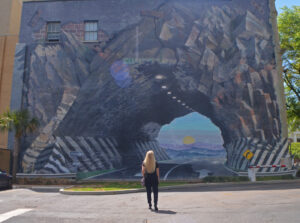
“Busted Plug” is the world’s largest (a colossal 3-stories high) fire hydrant weighing 675,000 pounds. Also by Blue Sky, this fun and unusual tourist attraction is made of steel and concrete and can withstand any natural disaster.
“Neverbust Chain,” also by Blue Sky, links two large office buildings. Rather than seek government approval (better to ask for forgiveness than permission, right?) they sought approval from the office buildings’ owners to weld the chain to hang in the alley above the two structures. Installed in 2000, the whimsical chain became such a big hit with locals and tourists, 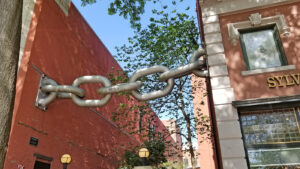 that the city embraced the creativity. According to Blue Sky, he installed the chain here because one of the buildings appeared to be leaning slightly. Which is either true or a clever PR ploy! And of course, Columbia has ubiquitous wings! Head to Hotel Trundle in downtown. They’re on the corner of the building next to the alley.
that the city embraced the creativity. According to Blue Sky, he installed the chain here because one of the buildings appeared to be leaning slightly. Which is either true or a clever PR ploy! And of course, Columbia has ubiquitous wings! Head to Hotel Trundle in downtown. They’re on the corner of the building next to the alley.
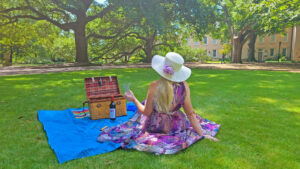
The sprawling campus of the University of South Carolina covers a huge part of the city center, the most beautiful area of which is the beautiful “Horseshoe,” a historic semi-circle of antebellum college-owned mansions, gardens, and old oak trees dripping with Spanish moss. Founded in 1801, the Horseshoe is the center of campus life, and there is not a more beautiful or peaceful place to enjoy a picnic lunch.
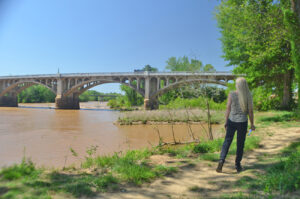 What better place for a stroll than along the Congaree River in West Columbia? This section of the Three Rivers Greenway runs along the west side of the Congaree River and passes under two bridges offering some incredible river views. With the picturesque Gervais Bridge and the cityscape of Columbia as the backdrop, visitors can choose to walk along the wooden boardwalk, or inch closer to nature on the dirt path close to the bank. Along the way are picnic tables, a riverside amphitheater, and a canoe launch bay. At the south end, the Columbia Riverwalk connects with the Cayce Riverwalk for those seeking an extended hike.
What better place for a stroll than along the Congaree River in West Columbia? This section of the Three Rivers Greenway runs along the west side of the Congaree River and passes under two bridges offering some incredible river views. With the picturesque Gervais Bridge and the cityscape of Columbia as the backdrop, visitors can choose to walk along the wooden boardwalk, or inch closer to nature on the dirt path close to the bank. Along the way are picnic tables, a riverside amphitheater, and a canoe launch bay. At the south end, the Columbia Riverwalk connects with the Cayce Riverwalk for those seeking an extended hike.
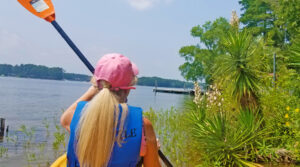
Called “the jewel of South Carolina,” shimmering, man-made Lake Murray is approximately 50,000 acres in size with more than 650 miles of shoreline. The lake is named after William Murray, the chief engineer who conceived what was “the world’s largest earthen dam” at that time. Although the lake was originally completed in 1930 as a hydroelectric generating facility, it has come to be known as a premier recreation destination in the Midlands of South Carolina. There are a variety of ways to get out on Lake Murray, and one of our favorites was kayaking. The water is pretty calm and there are a variety of lovely little coves to explore, as well as get out on the open water of the vast lake.
During the fall season, 80,000-seat Williams-Brice Stadium, Home of the University of South Carolina Gamecocks is the place to be. Opened in 1934, “The Cock Pit” is routinely praised for its electrifying atmosphere and  legendary tailgate parties, and game day roaring fans can be heard for miles around. USC recently produced superstars like defensive linebacker Jadeveon Clowney (who went on to play with the NFL Houston Texans) and offensive running back Marcus Lattimore (career record for rushing touchdowns). Two popular and sellout games include Parents’ Day, and the Thanksgiving Day game a.k.a. the Carolina–Clemson rivalry and officially dubbed the Palmetto Bowl. The “Tiger Burn” is a century-old pep rallly kicking off the week of rivalry. Another fun tradition is the “sandstorm” after a touchdown – thousands of small white towels twirled it in unison while the crowd chants “USC!”
legendary tailgate parties, and game day roaring fans can be heard for miles around. USC recently produced superstars like defensive linebacker Jadeveon Clowney (who went on to play with the NFL Houston Texans) and offensive running back Marcus Lattimore (career record for rushing touchdowns). Two popular and sellout games include Parents’ Day, and the Thanksgiving Day game a.k.a. the Carolina–Clemson rivalry and officially dubbed the Palmetto Bowl. The “Tiger Burn” is a century-old pep rallly kicking off the week of rivalry. Another fun tradition is the “sandstorm” after a touchdown – thousands of small white towels twirled it in unison while the crowd chants “USC!”
One of the first planned cities in the States, Columbia has a rich sometimes troubled history, and especially fascinating stories during the Reconstruction Era. Originally established in the 1700s, sadly most of the city’s old buildings and streets were burned down when General Sherman marched through South Carolina during the Civil War. Explore these houses and more Columbia history by visiting Historic Columbia.
Hampton-Preston Mansion
Listed in the National Register of Historic Places, the Hampton-Preston Mansion and Gardens was built in 1818 as a private residence. The pristine antebellum mansion with its Doric columns is one of Columbia’s
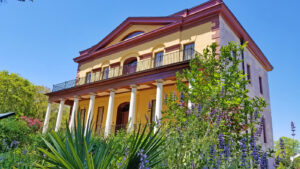 oldest remaining structures, once serving as a Union Army Headquarters during the Civil War and later as the Governor’s Mansion. The property is open to the public as a historic site, having recently undergone a massive renovation to the building and grounds. Visitors can take a tour that explores the lives of enslaved workers and their planter-class owners.
oldest remaining structures, once serving as a Union Army Headquarters during the Civil War and later as the Governor’s Mansion. The property is open to the public as a historic site, having recently undergone a massive renovation to the building and grounds. Visitors can take a tour that explores the lives of enslaved workers and their planter-class owners.
Woodrow Wilson Family Home
Built during Reconstruction, in 1871, the Woodrow Wilson Family Home is South Carolina’s only 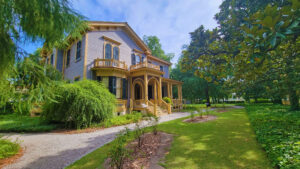 presidential site and the place where the 28th president (then called “Tommy) spent some of his childhood years, from 1871 to 1875. The home is a manse built in the style of an Italianate villa and is the only museum in the country to focus solely on the Reconstruction era. Visitors are immersed in the context of Columbia in the 1870s via a plethora of exhibits that record how both black and white inhabitants navigated the intensely political, social, and economic changes of the Reconstruction Era.
presidential site and the place where the 28th president (then called “Tommy) spent some of his childhood years, from 1871 to 1875. The home is a manse built in the style of an Italianate villa and is the only museum in the country to focus solely on the Reconstruction era. Visitors are immersed in the context of Columbia in the 1870s via a plethora of exhibits that record how both black and white inhabitants navigated the intensely political, social, and economic changes of the Reconstruction Era.
Robert Mills House and Gardens
One of five National Historic Landmarks in Columbia, this Classical Revival townhouse is the creation of
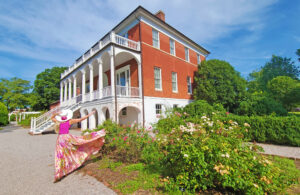 Robert Mills was the same architect that designed the Washington Monument (but very rarely designed houses). Originally designed in 1823 for a wealthy merchant of Columbia named Ainsley Hall and his wife, the building also served as a seminary and bible college. In 1961, the home was restored completely and then opened up as a house museum.
Robert Mills was the same architect that designed the Washington Monument (but very rarely designed houses). Originally designed in 1823 for a wealthy merchant of Columbia named Ainsley Hall and his wife, the building also served as a seminary and bible college. In 1961, the home was restored completely and then opened up as a house museum.
Mann-Simons Cottage
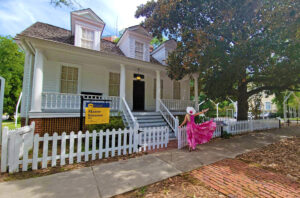
Mann-Simons Cottage is a historic 1.5-story home built around 1850 for a substantial free black Columbia family. The Mann-Simons Cottage isn’t as extravagant as Columbia’s other historic houses, but the home is an important city landmark as it features the life of Celia Mann, a free African American entrepreneurialwoman who lived on the property at a time when many of her fellow African-Americans were still enslaved.
Celia Mann was born in Charleston in 1799, and local legend says that she traveled to Columbia on foot. By 1844 she was living in the cottage and making her living as a midwife and her decedents lived there until 1970. Celia and her husband Ben Delane challenged social norms at a time when most African Americans were enslaved.
At sunset from the end of June to the beginning of August, more than one million of the famous Purple Martins, the largest of the swallow family, take flight in the skies over Bomb Island (once used as target practice during World War II) over Lake Murray. This extraordinary phenomenon happens as the birds venture north for the summer and roost on the island. The sanctuary provides the ideal pit stop for Purple Martins as they make the long journey south from Canada to their winter home in South America. Bomb Island remains the largest roosting site on the continent and is lush with shrubs and trees for perching.
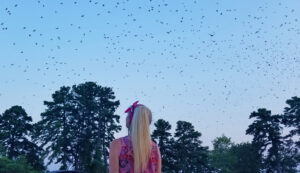
Local weather radar has shown that when the birds leave in the morning, the explosive image is larger than Hurricane Hugo was in 1989. The purple martins are not on the endangered species list; however, they have faced a significant decline in population in recent years due to a loss of habitat.
The best way to see the Purple Martins is to rent a boat and cruise to the known spots to wait for the sun to start going down. It’s magical! First, you hear them, then suddenly they are everywhere. It was 100 times more memorable than I ever imagined!
Just a 30-minute drive south of the city, the beautiful Congaree National Park covers a vast 26,000 acres of swamps, lush forestry, meadows, and paths. The picturesque grounds encompass the largest swath of old bottom-growth in the United States, as well as one of the world’s tallest deciduous broad-leafed forests in the world, with a greater number of 130’ to 160’ tall trees than any other place in Eastern North America. 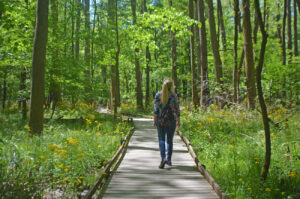 That’s taller than old-growth forests in Japan, the Himalayas, and Europe! After obtaining a map at the Visitor’s Center, nature enthusiasts can enjoy the biodiversity by hiking, kayaking, canoeing, kayaking, or fishing. One of the best features is the 2.4-mile Boardwalk Loop that winds over the swamp and meanders through the tall trees, fields of wildflowers, and past lakes.
That’s taller than old-growth forests in Japan, the Himalayas, and Europe! After obtaining a map at the Visitor’s Center, nature enthusiasts can enjoy the biodiversity by hiking, kayaking, canoeing, kayaking, or fishing. One of the best features is the 2.4-mile Boardwalk Loop that winds over the swamp and meanders through the tall trees, fields of wildflowers, and past lakes.
During the scorching summer days in Columbia, there is no better way to cool off than to grab a tube and experience the longest float trip in South Carolina! Palmetto Outdoor Center offers full-service outfitting with different types of tubes, life jackets, and shuttle service included in their fee. The adventure starts at the West Columbia Riverwalk and Amphitheater. From the Riverwalk, Palmetto Outdoor Center will shuttle you upstream about 2.5 miles to the put-in location where you will be issued your specific tube.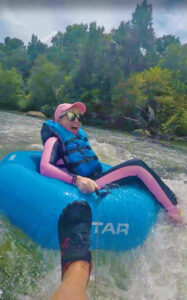 With a guide, you are required to carry your tube down to the river where you will listen to a safety speech before continuing down to the river. Note that the tubes are big, awkward, and somewhat heavy, so keep that in mind. After launching, it will take somewhere between two and four hours to float back down to the West Columbia Riverwalk where you originally parked. The time is dependent on how fast (or slow!) the river is flowing, and whether you want to paddle yourself forward or just relax for a lazy river float, as well as how much time you want to spend in the direct sun. This route includes a couple of places with Class I and Class II rapids — one to two feet tall rapids over rocks. You are guaranteed to get wet, but don’t worry: if you fall out, the water isn’t very deep. Be sure to wear water shoes for the river and the hot pavement when you return and walk back to your vehicle. I also wore a lightweight wet suit – because I’m not a huge fan of cold water (even during the height of the summer season, the water temps here barely reach 65 degrees), and also as protection from the hot sun. The last few hundred feet of your trip are the most scenic, as you get to float right under the historic Gervais Street Bridge.
With a guide, you are required to carry your tube down to the river where you will listen to a safety speech before continuing down to the river. Note that the tubes are big, awkward, and somewhat heavy, so keep that in mind. After launching, it will take somewhere between two and four hours to float back down to the West Columbia Riverwalk where you originally parked. The time is dependent on how fast (or slow!) the river is flowing, and whether you want to paddle yourself forward or just relax for a lazy river float, as well as how much time you want to spend in the direct sun. This route includes a couple of places with Class I and Class II rapids — one to two feet tall rapids over rocks. You are guaranteed to get wet, but don’t worry: if you fall out, the water isn’t very deep. Be sure to wear water shoes for the river and the hot pavement when you return and walk back to your vehicle. I also wore a lightweight wet suit – because I’m not a huge fan of cold water (even during the height of the summer season, the water temps here barely reach 65 degrees), and also as protection from the hot sun. The last few hundred feet of your trip are the most scenic, as you get to float right under the historic Gervais Street Bridge.
To find more activities and daytime events visit our website at Capital City/Lake Murray Country events page. The Midlands boasts a wide variety of things to do, from food festivals to art and entertainment to cultural, historical, and contemporary sites. Stop by the Lake Murray Country Visitors Center in the historic Lorick Plantation House to discover hidden gems and more trip ideas or, contact the Lake Murray Country staff at [email protected] for personalized service.
Written by: Patti Morow, Luggage and Lipstick
Photo credits: Kary Kern